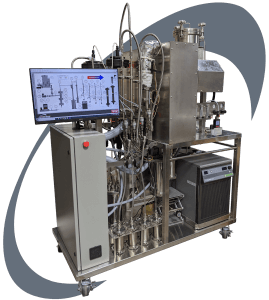02
Bioenergy
Biomass Conversion

Edit Content
Mainstream develops transportable pyrolysis reactors to convert lignocellulosic waste biomass and mixed waste to pyrolysis bio-oil. Moreover, we sell small 1 kg/hr benchtop pyrolysis systems to universities and laboratories engaged in biomass research. We also operate a 1 ton/day pilot reactor at our Rockledge, Florida facility. The pilot-scale reactor was developed for government applications, providing on-site renewable energy generation to improve energy security.
Edit Content
Most small-scale reactors operate by batch processing or handle minimal amounts of feedstock material. As a result, designing, building, and commissioning a custom bench-scale process can be highly time-consuming and costly. Mainstream has eliminated the inherent risk by developing a pyrolysis test platform and is offering the industry a standard system capable of process optimization, bio-oil upgrading, and bio-oil collection testing and research.
Mainstream’s continuous, bench-scale pyrolysis unit provides a reliable test platform for pyrolysis research. The biomass feedstock optimizes the fluidized bed reactor yielding bio-oil of 65%. This system ultimately provides the researcher the ultimate control and flexibility of process parameters (e.g., temperature, residence time) and bio-oil separation and collection.
Fluidized Bed Pyrolysis Reactor
It generates high bio-oil yields with biomass and mixed waste.
Continuous, 2 lb/h with controlled reactor and heated zone control
Two-stage cyclone separators
Efficient separation of pyrolysis char byproduct
Multi-stage condensers
Fraction condensation of bio-oil product
Touchscreen HMI
Automated control of pyrolysis conditions and process parameters. Fluidizing gas flow, reactor temperature, heated zone control, and user-programmable
Mainstream’s continuous, bench-scale pyrolysis unit provides a reliable test platform for pyrolysis research. The biomass feedstock optimizes the fluidized bed reactor yielding bio-oil of 65%. This system ultimately provides the researcher the ultimate control and flexibility of process parameters (e.g., temperature, residence time) and bio-oil separation and collection.
Fluidized Bed Pyrolysis Reactor
It generates high bio-oil yields with biomass and mixed waste.
Continuous, 2 lb/h with controlled reactor and heated zone control
Two-stage cyclone separators
Efficient separation of pyrolysis char byproduct
Multi-stage condensers
Fraction condensation of bio-oil product
Touchscreen HMI
Automated control of pyrolysis conditions and process parameters. Fluidizing gas flow, reactor temperature, heated zone control, and user-programmable
Table 1. Properties of Bio-oil from Bench-Scale Pyrolysis Unit
| Property | 100% Pine | 80% Pine: 20% Polystyrene |
|---|---|---|
| Temperature | 500 | 500 |
| Flow-Rate (L/min) | 17.0 | 17.0 |
| Residence Time (sec) | 0.73 | 0.73 |
| Density (g/ml) | 1.20 | 1.14 |
| Moisture Content, wt% | 18.1 | 15.0 |
| Elemental Analysis, Wet Basis | ||
| C | 45.6 | 71.6 |
| H | 5.0 | 5.0 |
| O | 49.4 | 23.4 |
| Elemental Analysis, Dry Basis | ||
| C | 55.7 | 84.2 |
| H | 3.6 | 3.9 |
| O | 40.7 | 11.9 |
| ph | 1.39 | 1.42 |
| Heating Value | 20.0 | 19.9 |
Table 2. Properties of Char from Bench-Scale Pyrolysis Unit
| Proximate Analysis | Composition (wt%) |
|---|---|
| Moisture | 2.27 - 6.03 |
| Volatile Matter | 15.54 |
| Fixed Carbon | 61.76 |
| Ash | 20.43 |
| Ultimate Analysis | |
| Carbon | 68.0 - 82.7 |
| Hydrogen | 3.31 |
| Nitrogen | 1.79 |
| Sulfur | 0.04 |
| Oxygen | 4.12 |
| HHV | 25.5 - 29.7 |
| Ash Constituents | |
| Calcium, CaO | 38.50 |
| Potassium, K20 | 16.50 |
| Silica, SiO2 | 12.00 |
| Aluminum, AL203 | 11.52 |
| Magnesium, MgO | 9.64 |
| Phosphorus, P202 | 4.67 |
| Ferric, Fe202 | 2.04 |
| Sulfur, S03 | 1.39 |
Edit Content
ref.
Schwartz, Nicholas. “PyNe 45.” Task 34: Direct Thermochemical Liquefaction, Dec. 2019, https://task34.ieabioenergy.com/wp-content/uploads/sites/3/2019/12/PyNe-45_final.pdf.
Schwartz, Nicholas. “PyNe 45.” Task 34: Direct Thermochemical Liquefaction, Dec. 2019, https://task34.ieabioenergy.com/wp-content/uploads/sites/3/2019/12/PyNe-45_final.pdf.
Edit Content
Operating Hours: Monday – Friday 8:00 a.m. – 5:00 p.m. EST
Contact: Send us an email – info@mainstream-engr.com
Phone: 321-631-3550
Contact: Send us an email – info@mainstream-engr.com
Phone: 321-631-3550